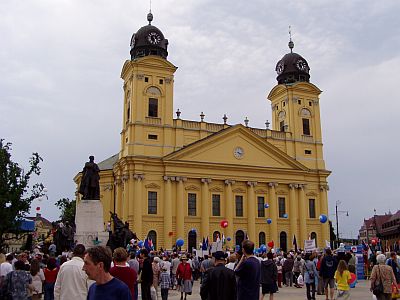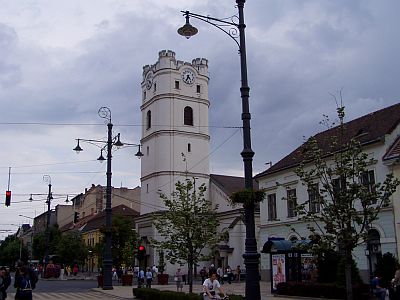Official Name
Debrecen. Also known as Debreczin, although this name is not very often used any longer.
Location

| ||
| Debrecen |
Debrecen lies in Eastern Hungary, more than 200 km east of →Budapest. The town occupies a small plateau at the edge of the Hortobágy (part of the Puszta or the Great Plain). The border to →Romania in the east is less than 30 km away. Debrecen is surrounded by the Debreczin Heath. Additionally, it marks the administrative centre of the Comitat (country) of Hajdú-Bihar
Population
Debrecen has more than 215,000 inhabitants, and so it's the second-largest city of Hungary. The comitat around Debrecen has more than 500,000 inhabitants.
Orientation
Debrecen gradually developed into a large town, and this can be seen in the centre of town. Unfortunately, massive air raids in 1944 had left their marks in the centre as well, and so there are many new buildings. The large Nagyállomás (main train station) lies south of the city centre and is more than 1 km away from the central square. However, the tram (line No 1 - no chance to get lost, there's only one line!) connects the train station with the centre, so it's very simple to get around. The tram runs along the broad Piac utca (Market St). Somewhere in the middle, Piac ut. meets Széchenyi/Kossuth St. From there, it becomes a pleasant pedestrian zone. Piac ut. finally ends at the large Kossuth tér (Kossuth Square). This square is a modern and newly designed, beautiful pedestrian zone as well. Almost all sights of the town concentrate around Kossuth square. Further to the north, there are many wide parks. The tram runs all the way to the parks before it returns to the train station.
History
Debrecen was first mentioned in 1235, but it wasn't granted urban rights before the year 1361. The town developed slowly but steadily into the most important trading place of the region. After the reformation had reached Hungary, Calvinism grew stronger in Debrecen. Even today, the town is also called Rome of the Calvinists genannt.

| ||
| Debrecen: Csokonai Theatre |
In 1693, the town was granted the status of a 'Royal Free Town'. Especially during the 19th century under the reign of the Habsburg Monarchy, Debrecen experienced a construction boom. Most parts of the town as they can be seen today date back to that time.
During the revolutin in 1848/49 (see →History of Hungary), the town played a very important role. It even became the capital of Hungary for a short period of time. In 1857, the railway (at that time a revolutionary invention) between →Pécs and Debrecen was completed. This initiated a boom in Debrecen. The industrialization started, and Debrecen developed into the most important transport hub of Eastern Hungary. Additionally, a university was founded.
When the front line approached Debrecen in 1944, the town suffered heavy air raids. Debrecen and the rest of Hungary was finally liberated in December 1944. Since →Budapest didn't surrender before April 1945, Debrecen became the capital of Hungary again. After 1989, Debrecen enjoyed a massive face-lift. Modern Debrecen is an important industrial and university town, and besides that it's also an important religious centre.
Getting there / transportation
As already mentioned above, Debrecen is an important transport hub. Numerous daily trains run to Miskolc (2 hrs), Nyíregyháza (30 minutes and more), Mátészalka (1½ h, 700 ft) etc. Of course there are also direct trains to and from →Budapest. The express train (IC) needs around 2 hrs for the trip, the fare is 2130 ft + 480 ft reservation fee - altogether around € 10.
The best way to get to Romania is to catch a local train to Valea Lui Mihai. From there, it's easy to get to →Oradea in the south and to →Satu Mare in the north. The train from Satu Mare to Debrecen needs around 1¼ hrs, but there are only two departures a day: 5 am and 11:18.
In Debrecen (as well as in some other Hungarian cities), everything concentrates around Kossuth tér (tér = square). Lajos Kossuth was one of the leaders of the revolution in 1848. There's also a monument in the middle of the square dedicated to him. The first thing visitors will notice is the yellow Nagytemplon (Large Church), which is a reformed church. The huge classicistic structure was built atop the ruins of an older church at the beginning of the 19th century and is clearly dominating the square. Talking about the square again: It's a popular meeting place, and so it's already full of people. It's also used as a stage for numerous festivals and other events. Right behind the church there's a small park, the Déri Múzeum and a reformed college.

| ||
| Nagytemplom - the large church facing the central square |
Many old houses line up along the main road Piac utca (Piac St), depicting the development boom during the 19th century. Among those buildings, the huge Hotel Aranybika at Kossuth Square and the beautiful Tisza Palace are worth mentioning. Some hundred metres south of Kossuth square, there's another church at Révész Square. It's the Református Kistemplom (Small Reformed Church), characterized by its unusual tower. Something is missing there: The construction was completed in 1726, but only one year later the church was destroyed by fire. The church was rebuilt and topped with a brass dome. Many years later, the small dome was substituted by a typical Russian, onion-shaped steeple. However, a storm damaged the structure seriously in 1907, and the rest of the tower blew down during another storm. The citizens gave up, and so a small bastion was added.

| ||
| The Kistemplom - something's missing here |
When you turn into Kossuth rd from the church and walk up east, you will soon get to the Csokonai Színház (Csokonai Theatre) and the small Görög Katolikus Templom (Catholic Church) with it's needle-like tower. Other sights include beautiful old houses and a large building in the Hungarian Art Noveau style. The surprisingly small but beautiful Városháza (City Hall) is also worth a closer look. All in all, it's a charming town without real attractions - but thanks to the atmosphere you won't miss anything.
We arrived in Debrecen on a Sunday - and the tourist information was closed. Finding reasonable accommodation in Debrecen without the help of a tourist information (and without a guidebook) proved to be difficult. There are some old and large hotels in the centre, but they are all rather expensive.
North of central Kossuth square, Péterfia Utca runs northwards to the parks. There are two small hostels next to each other on the right side of the street (when you come from the centre) . The first one is called Centrum Panzió and has a long and very nice garden with some wooden cabins, all of them with a bathroom, a veranda and more. Nice and modern rooms cost 3,500 ft (€ 14) per person. Thinking about the comforts and the location, it's a very good price. The next tram stop is only a few metres away. As mentioned above, the tram runs between the parks in the north via the central square to the train station. There's also a large shopping mall incl. a supermarket nearby. Address: Péterfia Utca 37/A, Tel. & Fax: (052) 442 843. URL: http://web.axelero.hu/centrum.
There's no need to starve in Debrecen. Lucullus Étterem, Piac u. 41, is a lovely restaurant serving authentic Hungarian food. Service, atmosphere and the food are excellent. Main dishes are more expensive than usual (€ 4 - 10) but it's worth the money.
- www.debrecen.hu Official website of Debrecen, incl. an extensive English version. Helpful.
Do you have or do you know a good website about Debrecen? Don't hesitate, let me know! After checking it, I would love to add it to the link list. You can submit a link by using the →contact form. Note that commercial websites will be treated differently.
©2024 Europe-East.com

 Albania
Albania Hungary
Hungary